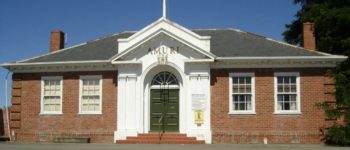1852: Culverden
April 21, 2019
By AHNZ
 Staightening the curves and flattening the hills is only cool when the Duke Boys do it. This is the equivalent to sending your unique and beloved kid to military school to have their personality expunged. That’s what’s happening now with Highway 7’s latest roading project..
Staightening the curves and flattening the hills is only cool when the Duke Boys do it. This is the equivalent to sending your unique and beloved kid to military school to have their personality expunged. That’s what’s happening now with Highway 7’s latest roading project..“Work costing $760,000 is under way to level some of the bumps..”- End of the road for beloved bumps on Christchurch to Hanmer Springs highway; Stuff
The First State Highway 7, 1852
Amuri Road Board (c.1866) then Amuri County Council (1877-1989) built these roads up from sheep drover’s tracks. Initially there was no road south at all and the Amuri had to be approached from Nelson in the north. Back in c.1852 there was a race to claim the land by stocking it between rivals Henry Young and Edward Minchin. Out of this came Culverden’s first settler- Samuel Mannering.Wealthy Young deployed the 17yo Mannering on a 386km drove into this heart of darkness. After 56 days the two drovers and one bushman returned to Nelson, leaving the young teen to stick it out¹ with the sheep and the predatory wild dogs. This lonely and primitive life tending sheep as a human claim-staking post went on for 15 months. Eventually, Young himself showed up as he had promised and relieved Mannering. The young man, it seems to me, had been sorely misused so no wonder he headed home to his family in England².
“The journey was very rough going for Mannering, the lovely iconic bumps about to be erased by the New Zealand Transport Agency are the last historic monument to our pioneers’ adversity.”
During this time of isolation, young Samuel attempted the trip down the future Highway 7 to Christchurch. The journey was very rough going for Mannering, the lovely iconic bumps about to be erased by the New Zealand Transport Agency are the last historic monument to our pioneers’ adversity. Leaving his cob hut, which Young would later homestead (not personally, of course) as Culverden Station, Samuel cut his own trail down to Mt. Grey Station on his horse. From there through the Rangiora Bush through Charles Torlesse’s territory, over the Waimak’ river via Maori canoe, through Papanui bush to the dirt roads of Christchurch.
This was in 1852 when a few wooden buildings (mostly in Colombo Street) were all there was of Christchurch, except survey pegs. There was still no sign of Young, so Mannering got another horse, a packsaddle, and what stores he wanted, on credit from Isaac Cookson, the leading Christchurch merchant of those days, and went back to his job. This was a good performance for a boy of seventeen.- Acland
Thus, the first record of what would become Highway 7.
A long time ago came a man on a track
Walking thirty miles with a sack on his back
And he put down his load where he thought it was the best
Made a home in the wilderness– Telegraph Road; Dire Straits
Big Government Takeover
“Long ago the country bore the country-town and nourished it with her best blood. Now the giant city sucks the country dry, insatiably and incessantly demanding and devouring fresh streams of men, till it wearies and dies in the midst of an almost uninhabited waste of country.”- Oswald Spengler
2 thoughts on "1852: Culverden"
Leave a Reply
 Like Comment Share
Like Comment Share






Henry Young moved to Ermedale and Mount Otapiri near Invercargill, then, with children mostly born at Nelson and Motueka, in 1878, to Bundaberg, Australia and sugar farming. In NZ he tried to raise sheep for wool. Always elusive. Refrigeration was invented just when he went to Australia.
Thanks for that. It occurs to me that Young deployed Mannering after the same pattern that Charles Clifford deployed Frederick Weld about 5 years before. It worked out well in the end for the earlier pair, somehow or other. Interesting to compare.